
Down the ages, rulers and conquerors have fused the imprint of their culture and civilization with local traditions in art and architecture. The heritage left to us is a mosaic of Indo-Saracenic, Chalukyan, Hoysala, Chola, Dravidian, Mughal, and Jain architecture.
DAY ONE :
Arrive at Kundapur in the
evening.
DAY TWO :
Start from Kundapur and
arrive at Dandeli wildlife sanctuary. Spend the day. OR Visit Banavasi, the
second century Kadamba Temple and halt at Hubli.
DAY THREE:
Leave Hubli at 6.30 a.m.
Visit the temple in Banashankari. Go to Badami. Leave for Bijapur. Halt for the
night.
DAY FOUR :
Visit Golgumbaz and other
Historic monuments in Bijapur.
DAY FIVE :
Leave for Aihole, visit
the old Ruins. Visit Pattadakal, the place known as the cradle of Indian
Architecture. Proceed to Hampi.
DAY SEVEN :
Leave Hampi at 07.00 a.m.
Stop for Lion Safari. Arrive at Kundapur in the evening.
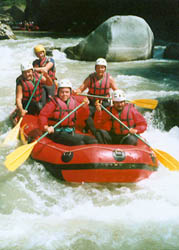 Dandeli
is the
gateway to the 834 sq. km. Dandeli Game Sanctuary. It is home to
rare species of animals, like barking deer, sloth bear, civet cat,
panther, Flying Squirrel and Malabar Squirrel. Woodpeckers and
Hornbills are some of the birds sighted. Experience the thrills of jungle
life by staying at the Kali Wilderness Camp, located on the edge of
the Kali River or at the Bison River Resort. Ride down the Kali
river in a coracle (round basket like boat), where you can watch
crocodiles basking on the banks and water birds nesting. You can
also take a jeep
safari or walk along the nature trails in the forests.
Dandeli
is the
gateway to the 834 sq. km. Dandeli Game Sanctuary. It is home to
rare species of animals, like barking deer, sloth bear, civet cat,
panther, Flying Squirrel and Malabar Squirrel. Woodpeckers and
Hornbills are some of the birds sighted. Experience the thrills of jungle
life by staying at the Kali Wilderness Camp, located on the edge of
the Kali River or at the Bison River Resort. Ride down the Kali
river in a coracle (round basket like boat), where you can watch
crocodiles basking on the banks and water birds nesting. You can
also take a jeep
safari or walk along the nature trails in the forests.
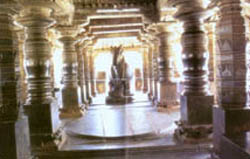 Banavasi
was established as the capital city of the Kadamba kings who ruled the
first Kannada Empire in c. 345AD. The Madhukeshwara Temple, is famed for
its architecture, deriving its name from the honey coloured Linga. Of
special interest is the intricately carved stone bed.
Banavasi
was established as the capital city of the Kadamba kings who ruled the
first Kannada Empire in c. 345AD. The Madhukeshwara Temple, is famed for
its architecture, deriving its name from the honey coloured Linga. Of
special interest is the intricately carved stone bed.
The annual cultural festival "Kadambatsava" is held in the month of December.
Nandi at Madhukeshwara Temple, Banavasi.
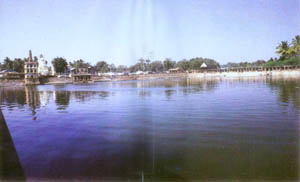 Five km from Badami,
Banashankari is one of the most ancient shrines in Karnataka, dedicated to
the goddess. Harishchandra Theertha, a large sacred pool in front of the temple is a
fine example of Chalukyan architecture.
Five km from Badami,
Banashankari is one of the most ancient shrines in Karnataka, dedicated to
the goddess. Harishchandra Theertha, a large sacred pool in front of the temple is a
fine example of Chalukyan architecture.
Harishchandra Theertha, Banashankari
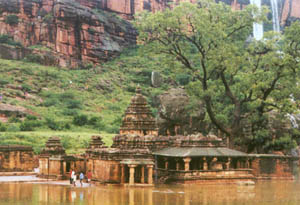
Bhuthanatha Temple, Badami
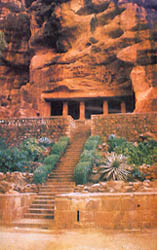 Whilst the first three
caves are dedicated to the Gods of the Hindu pantheon, the last cave is a
Jain Temple which has several Jain deities including a huge idol of
Parshwanatha. The first cave is dedicated to Shiva and contains the
beautiful image of Nataraja (Dancing Shiva) with eighteen arms. The
other sculptures are those of Ardhanareeshwara (half man and half woman),
Harihara and Parvati. The third cave, dedicated to Vishnu, has a
large image of Trivikrama and Vishnu sitting on the coiled serpent,
Adisesha. The caves overlooks a large lake, at the eastern edge of
which, are the waterside Bhuthanatha temples. At the north west of
the lake is the Archaecological Museum, which has superb examples of local
sculpture.
Whilst the first three
caves are dedicated to the Gods of the Hindu pantheon, the last cave is a
Jain Temple which has several Jain deities including a huge idol of
Parshwanatha. The first cave is dedicated to Shiva and contains the
beautiful image of Nataraja (Dancing Shiva) with eighteen arms. The
other sculptures are those of Ardhanareeshwara (half man and half woman),
Harihara and Parvati. The third cave, dedicated to Vishnu, has a
large image of Trivikrama and Vishnu sitting on the coiled serpent,
Adisesha. The caves overlooks a large lake, at the eastern edge of
which, are the waterside Bhuthanatha temples. At the north west of
the lake is the Archaecological Museum, which has superb examples of local
sculpture.
Entrance to Cave Temples, Badami
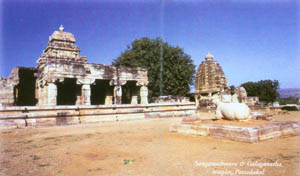 Twenty-two
km from Aihole, on the left bank of the Malaprabha river lies Pattadakal.
It is the second of two capitals of the Chalukyas, used mainly for the coronations of
kings. Pattadakal, declared by UNESCO as a World Heritage Site, was
an experimentation ground for temple architecture. Two
main types of temple architecture are laid out side by side. On the one
side, stand the curvilinear shikaras (spires) of the Kasivishweshwara,
Jambulinga, and the Galaganatha temples, and on the other the Mallikarjuna,
Sangameshwara and the Virupaksha temples with their square roofs and
receding tiers.
Twenty-two
km from Aihole, on the left bank of the Malaprabha river lies Pattadakal.
It is the second of two capitals of the Chalukyas, used mainly for the coronations of
kings. Pattadakal, declared by UNESCO as a World Heritage Site, was
an experimentation ground for temple architecture. Two
main types of temple architecture are laid out side by side. On the one
side, stand the curvilinear shikaras (spires) of the Kasivishweshwara,
Jambulinga, and the Galaganatha temples, and on the other the Mallikarjuna,
Sangameshwara and the Virupaksha temples with their square roofs and
receding tiers.
The most important monuments here are the Virupaksha & Mallikarjund temples built between 740 to 745 A.D to commemorate the victory of Vikramaditya the 2nd, over the Pallavas of Kanchipuram.
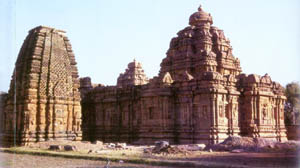
[1] Sangameshwara & Galaganatha Temple, Pattadakal
[2] Kashi Vishwanatha & Mallikarjuna Temples, Pattadakal
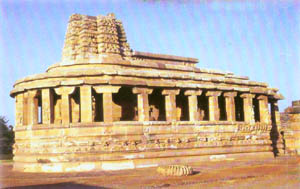 Aihole
was the capital of the Chalukyan kings, between the 4th and 6th century
A.D., when they began experimenting with the idea of constructing temples
with blocks of stone. The evidence of
Hindu temple architecture seen here indicates a growth from an early
embryonic stage to more complex forms. Simple shrines like those in the
Konthigudi group and the Lad Khan temple, developed to the more complex
edifices, such as the Meguthi temple. Aihole has over 125 temples all intricately
carved and rich in details.
Aihole
was the capital of the Chalukyan kings, between the 4th and 6th century
A.D., when they began experimenting with the idea of constructing temples
with blocks of stone. The evidence of
Hindu temple architecture seen here indicates a growth from an early
embryonic stage to more complex forms. Simple shrines like those in the
Konthigudi group and the Lad Khan temple, developed to the more complex
edifices, such as the Meguthi temple. Aihole has over 125 temples all intricately
carved and rich in details.
The oldest temple here is the Lad Khan temple darting back to 5th Century A.D. The Durga temple has a semi circular apse and a sanctum, encircled by a richly carved colonnaded passageway. The Hutchamalli temple, the Ravalphadi Cave Temple, the Konthi temple complex, the Jain Meghuthi temple and the two storied Buddhist temple are the sites worth visiting.
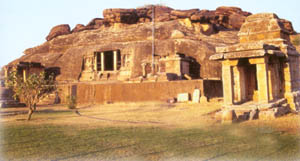
[1] Durga Temple, Aihole
[2] Ravalapadi Cave Temple, Aihole
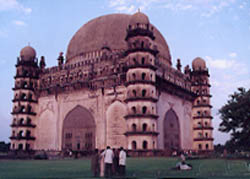 Bijapur
was the capital city during the Adil Shahi dynasty. It has its share of
historical, cultural and architectural interest. Gol Gumbaz, Jumma Masid
and Malik – e – Maidan lie within its environs.
Bijapur
was the capital city during the Adil Shahi dynasty. It has its share of
historical, cultural and architectural interest. Gol Gumbaz, Jumma Masid
and Malik – e – Maidan lie within its environs.
City Sights:
Gol Gumbaz, is believed to be the
second largest tomb in the world. The circular dome has a diameter of 44
metres. There are no supports within its span, giving it the illusion of
an unsupported structure.
A mere murmur from its whispering gallery is echoed seven times over before it dies out.
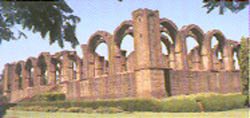 Jumma Masjid:
Jumma Masjid:
Jumma Masjid is still used for worship and has been called one of the finest mosques in India. It holds an exquisite copy of the Koran. The script is embossed in gold.
Ibrahim Roza, the mausoleum of Adil Shahi II is said to have inspired the architects of the Taj Mahal.
The Barah Kaman
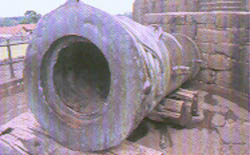 The Malik – e – Maidan is believed to be the largest medieval
cannon in the world. It is 14 ft. long and is estimated to weigh 55 tons.
Legend has it that, whoever touches the gun and makes a wish, will have
that wish fulfilled.
The Malik – e – Maidan is believed to be the largest medieval
cannon in the world. It is 14 ft. long and is estimated to weigh 55 tons.
Legend has it that, whoever touches the gun and makes a wish, will have
that wish fulfilled.
The largest medievel cannon Malik-e-Maidan
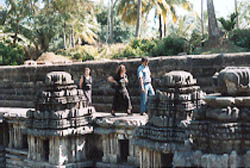 Another
world heritage centre is located in Hampi, the erstwhile capital of the
Vijayanagar kingdom. It is the most beautiful ruins in Karnataka, which
above others evokes the spirit of an age long lost. It abounds with
delightful surprises.
Another
world heritage centre is located in Hampi, the erstwhile capital of the
Vijayanagar kingdom. It is the most beautiful ruins in Karnataka, which
above others evokes the spirit of an age long lost. It abounds with
delightful surprises.
Here you can see the scales on which kings weighed themselves against grain, gold or money, which they later distributed to the poor.
The queens bath, with its arched corridors, projected balconies and lotus shaped fountains that once sprayed perfumed water is another wonder.
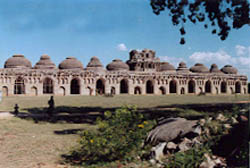 The
huge elephant stables, the two storied Lotus Mahal which is designed in
such a way when the atmospheric temperature goes up the water in the tank
starts circulating in the hollow place inside the wall keeping the room
cool. The circulated water goes back to the overhead tank, gets cooled
& again starts circulating. The magnificent Vithala Temple with its
musical pillars and stone chariot and the Virupaksha Temple that is still
used for worship will add to your astonishment.
The
huge elephant stables, the two storied Lotus Mahal which is designed in
such a way when the atmospheric temperature goes up the water in the tank
starts circulating in the hollow place inside the wall keeping the room
cool. The circulated water goes back to the overhead tank, gets cooled
& again starts circulating. The magnificent Vithala Temple with its
musical pillars and stone chariot and the Virupaksha Temple that is still
used for worship will add to your astonishment.
The 6.7m monolith Ugra Narasimha, the Pushkarini tank, the Mahanavani Dibba and so much more are there to be discovered.
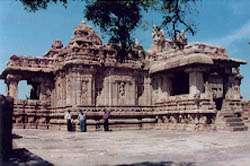 Local Festivals:
Local Festivals:
The Vijayanagar Festival is organised by the Government of Karnatka in December. Dance, drama, music, fireworks, puppet shows, spectacular processions... all combine to re-create the grandeur of the bygone era.